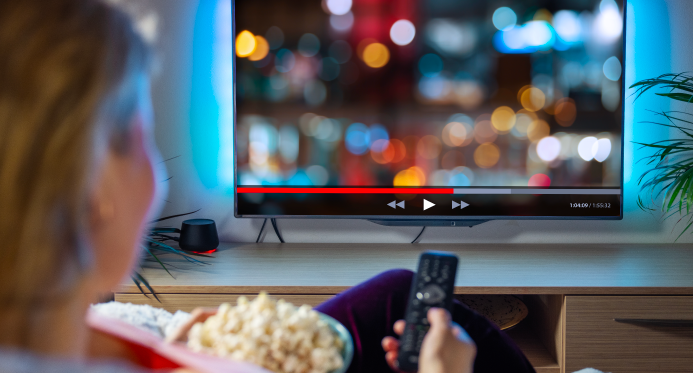The answer: keep your service competitive and your users happy. With personalization, you create unique experiences that keep viewers returning to your TV platform.
Personalization is more than a modern buzzword- it’s a critical factor that can propel TV service providers toward greater customer satisfaction and market differentiation. 71% of consumers expect companies to deliver personalized interactions. As we navigate an era where consumers are bombarded with choices, adjusting services to fit individual preferences can significantly enhance the overall user experience. By tailoring content recommendations, user interfaces, notifications, promotions and advertising to individual viewer preferences, TV service providers can distinguish themselves and deliver a unique entertainment experience. The proof is in the results; for example, including personalization on the homepage can increase CTR by 80-90%. Let’s dive into why focusing on personalization will benefit TV service providers and their subscribers.
Understanding consumer behavior and preferences
Providers must delve deeper into understanding consumer behavior and preferences to achieve successful personalization in TV services. However, this is not always the case, 60% of viewers think that personal recommendations reflect OTT services’ marketing efforts rather than tailor-made content for them. This is where many services are limited today, only offering recommendations based on editorial favorites and genres. By adding the users’ viewing patterns, demographics and feedback, providers can tailor content and recommendations to meet the specific interests of their audience. This data-driven approach allows for more accurate targeting, leading to higher viewer satisfaction and engagement. Additionally, keeping up with the changing trends and preferences in the market enables providers to adapt their offerings swiftly, staying ahead of the competition.
The impact of personalization
Personalization in TV services goes beyond just recommendations and user interfaces. It has a deep impact on user satisfaction, loyalty and ultimately, the bottom line. Providers can create targeted content that resonates with their audience by understanding viewers’ preferences and behaviors, leading to increased engagement and retention rates. In addition, to keep their users happy, service providers can optimize revenue streams by delivering relevant messages to consumers, maximizing the effectiveness of marketing efforts with improved targeted advertising. With XroadMedia, one large European operator increased their TVOD revenues by 26% by implementing personalization strategies in addition to their editorial approach. As providers continue to prioritize personalization, they are not only enhancing the viewing experience but also securing their position in the competitive TV service industry. Personalization can have a positive effect on many KPIs for services focusing on engagement and revenues. Here are the three ways that personalization delivers results:
1. Enhanced Customer Experience
By leveraging data such as viewing habits, genre preferences and viewing times, TV service providers can curate content that appeals directly to each subscriber. This level of customization means users spend less time searching for something to watch and have more time enjoying content that resonates with their personal tastes and even their moods. For example, suppose similar content has been watched frequently. In that case, shows can be automatically suggested when new episodes are released, or the user interface can be adjusted to highlight favorite genres or hide uninterested categories. This is something that XroadMedia has done with one client, True Digital, where a row containing niche content moved from 17th to 5th position, helping increase engagement by a boost of 600 clicks.
2. Increased Customer Loyalty and Retention
When customers feel that their preferences are recognized and catered to, their loyalty to the service naturally increases. When done right, personalization makes customers feel valued and understood, which is crucial in an industry as competitive as M&E. By offering a tailor-made experience, OTT providers can minimize the common triggers for customer churn, like dissatisfaction and frustration. According to Google, 79% have kept a subscription after discovering new content.
3. Improved Monetization Strategies
Being the cheaper alternative, the popularity of ad-supported and FAST services has increased massively with consumers. A recent study has found that viewers don’t mind ads, but they demand good ad experiences. Now, personalization is needed to improve the ad experiences. The opportunity for advertisers and service providers is huge, while streaming OTT, 40% of people have paused their program to research or purchase what was advertised. Adding personalization to adverts or, at the very least, tailoring IAB categories to match user profiles, can generate a positive outcome for both the viewer and the service provider. By showing your users you know them with relevant ads, not only helps with the ROI of ad revenue but also helps build trust between providers and consumers, establishing a loyal subscriber base.
Implementing personalization strategies for TV providers
Implementing personalization strategies for providers involves utilizing advanced analytics and data-driven insights to understand viewer preferences. Getting segmentation and content recommendations right is the beginning of creating enhanced viewing experiences. Integrating interactive features such as customized, personalized playlists can further improve customer engagement and satisfaction. Through continuous monitoring and refinement of personalization efforts, TV providers can stay ahead in the competitive landscape by effectively meeting their audience’s evolving needs and expectations. In a saturated market, half of the battle for user attention lies outside the platform, which is why, at XroadMedia, we believe personalization should go beyond the UI. The implementation of personalization is not an overnight process; it requires a deliberate strategy, which involves several levels of customer interaction and a variety of continuously tested and improved solutions. Below are some strategies that can help TV service providers personalize their services effectively.
Data is the Foundation
The foundation of personalization is user data and based on that information, the best decisions are made for each user. Service providers must implement robust systems to gather accurate and relevant data without compromising customer privacy. Detailed analytics can then be used to understand customer behaviors and preferences at a granular level. As well as user data, the more content metadata a service has available, the more accurate the recommendations will be. Limited metadata, which usually only includes titles, genre and length of content, is typically the cause of lousy personalization. To help reduce the time that viewers are searching for content to watch, you can enhance your metadata with XroadMedia. A recent Hub Entertainment survey found that only 10% of respondents say that streaming services’ recommendations consistently match their interests. Together, a deeper understanding of your user and detailed metadata can increase the consistency of TV recommendations.
Customized Content Recommendations
Content recommendations need to be integrated across different devices, for all their users. At the same time, personalization use cases and applications should be adjusted to the different needs of the users. This means personalization might look different, for example, based on the device or section within a UI, to cater to different input mechanisms, interaction possibilities or viewing settings – just to name a few. Today, the time and frustration involved in trying to find something to watch are only increasing for consumers. Comcast found that 51% of users state that the difficulty of finding something to watch can get frustrating. To help improve the viewing experience, a dynamic UI that keeps content relevant and engaging for users should be continuously tested, as should the algorithms that power it.
Interactive Features and Advanced Search
Adding interactive features can significantly personalize the user experience by allowing viewers to engage with content in real-time. Features like live polls, interactive ad choices and social sharing capabilities make watching TV a more dynamic and personalized event. Personalization of search involves tailoring search results based on each individual user’s preferences. Search experiences should analyze previous search history, the types of content users regularly watch, and the intent behind their search terms to provide an excellent user experience.
It’s not all plain sailing, keep an eye out for the next blog in the series, where we are looking at the challenges and what is next for TV services. If you want to kick-start your personalization journey, get in touch with our experts.





